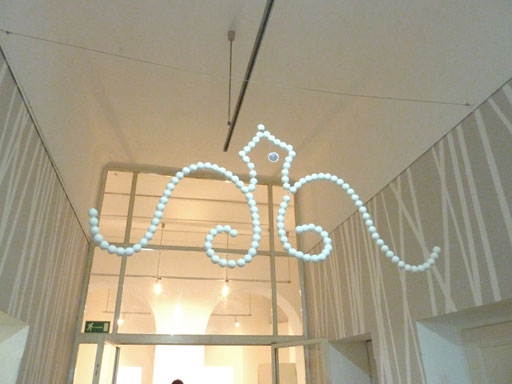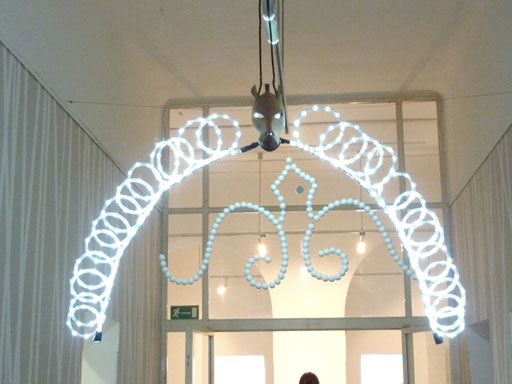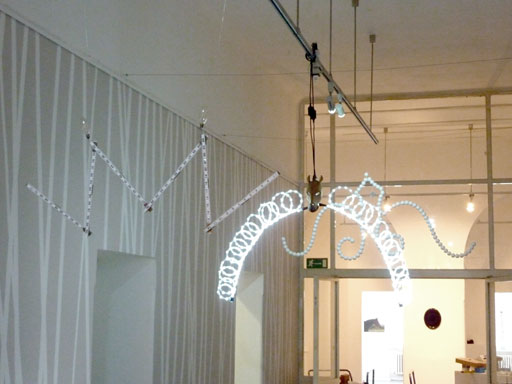Derridas Katze
Derridas Katze...
que donc je suis (à suivre)
Kunstraum Kreuzberg / Bethanien
Berlin
January, 30th - March, 7th 2010
Carla Åhlander, China Åhlander, Gehrd Grothusen, Ethan Hayes-Chute, Sylvia Henrich, Herorats, Ingvild Hovland Kaldal, Ane Lan, Lotte Konow Lund, Tea Mäkipää, Ulrike Mohr, Susanne Nissen, Yuka Oyama & Becky Yee, Juan Pancorbo, Lucy Powell, Petri Raappana, Peter Nansen Scherfig, Louise Schrader, Nino Sekhniashvili, Starship (Ariane Müller & Martin Ebner), Lisa Strömbeck, Eve K. Tremblay, Gernot Wieland
Curated by Alice Goudsmit in cooperation with Barbara Buchmaier.



Starship (Ariane Müller & Martin Ebner), Various Sketches for Leaving the Room
mixed materials, wallpainting, Kunstraum Kreuzberg, 2010
The exhibition Derridas Katze (Derrida´s Cat) examines the relationship between humans and animals, taking as its starting point the assumption of an existing interdependency between humans and animals, which cannot be defined solely as utilitarian, from a human point of view, nor understood through language or scientific models alone.
For thinking concerning the animal, if there is such a thing, derives from poetry.
Jacques Derrida
Through the works and projects of 25 artists, the exhibition Derridas Katze takes a critical look at the established narcissism of the human race and its conceptual roots. Human beings use and need animals for food, labour and love, as projection surface and as a symbol for our superiority. Whether or not animals need humans, on the other hand, is debatable and to a large extent, species-dependent. For example, the dog has lived by man's side for 130,000 years and seeks out human company of its own accord, while other, threatened species have become dependent on human beings only because we have changed their living conditions to such an extent that they can survive only with human assistance.
The ethical issues that this raises, and the theoretical arguments they have provoked will be reflected in the exhibition Derridas Katze. In an ironic affirmation of the man´s assumed superiortiy, the human gaze - analytical and therefore distanced - as vantage point and perspective is the subject of the exhibition.
(à suivre) / (to be continued)
Inspired by philosopher Jacques Derrida´s deconstruction and reshaping of the conceptual foundations of human ideals of dominion, the exhibition is conceived as a loose collection of materials, deliberately incomplete. In our culture man has always been the result of a simultaneous division and articulation of the animal and the human, in which one of the two terms of the operation was also what was at stake in it.
To render inoperative the machine that governs our conception of man will therefore mean no longer to seek now - more effective or more authentic - articulations, but rather to show the central emptiness, the hiatus that - within man - separates man and animal, and to risk ourselves in this emptiness: the suspension of the suspension, Shabbat of both animal and man.
Giorgio Agamben
*Derrida´s Cat
Jacques Derrida enters his bathroom. He is naked. His cat is sitting in the bathroom, observing him. Not any cat, but a specific cat, one sharing his living space. The cat sees him naked. The feeling of nakedness, evoked by the gaze of another being (the totally other), gives Derrida reason to concider why he feels naked (vulnerable), and why this moment of being observed, being caught by the glance of a cat (his cat), is essential to thinking about human-animal relations.
The autobiographical animal, the human, defines himself - anchored in the story of Genesis - through the privilege of naming and classifying the other creatures. According to humanist ideals, the subjectitivity of thinking and individuality are unique to mankind. Undisputed, they become the justification and motivation for a violent realisation of domination.
... que donc je suis / that therefore I am / what I am following
But the cat also sees him. And when he turns his back to the cat, it is still watching him. Consequently he is also subjected to the individual gaze of an (his) animal.
In recognition of the singularity, individuality and autonomy of the animal,
the argument for the dominance of the human might even dissolve.
Whenever autonomous individuals meet, the possibility of exchange, of dialogue, exists - so is this the case between humans and animals too ?*
